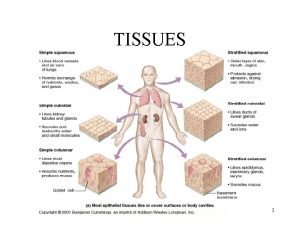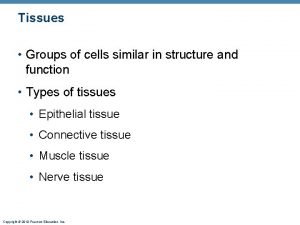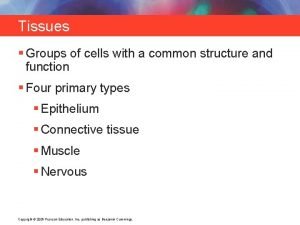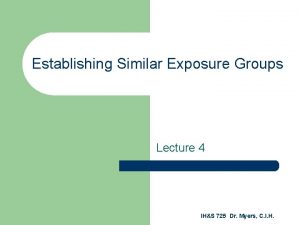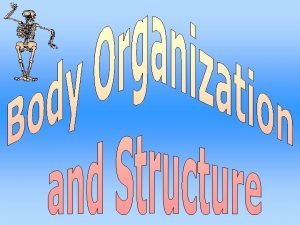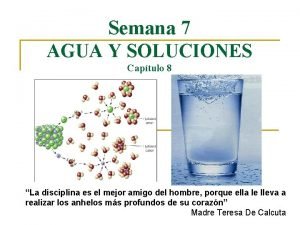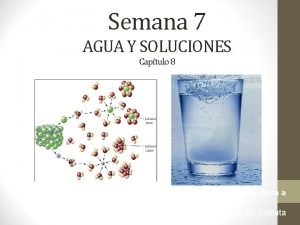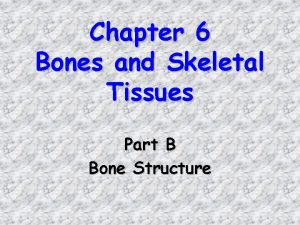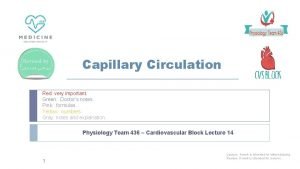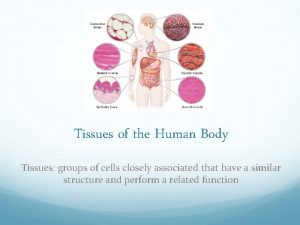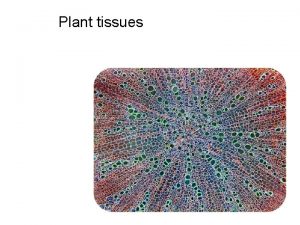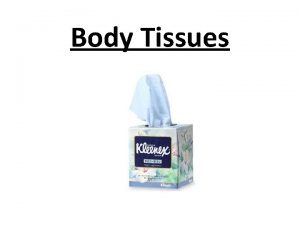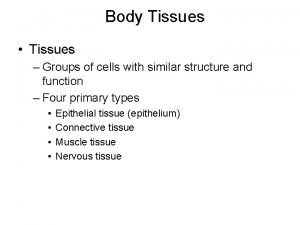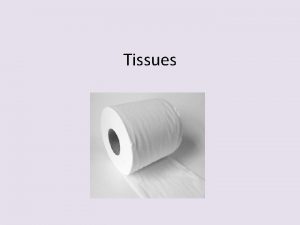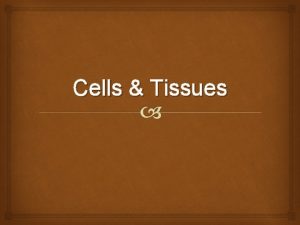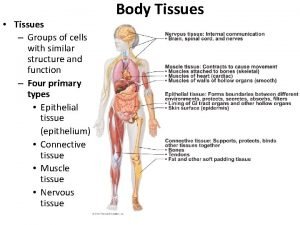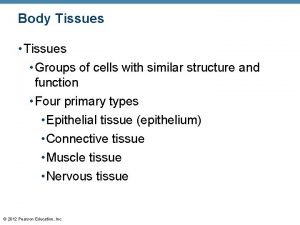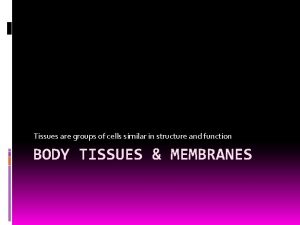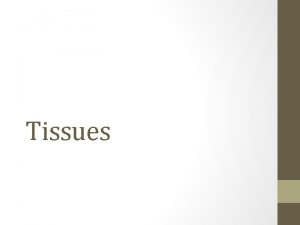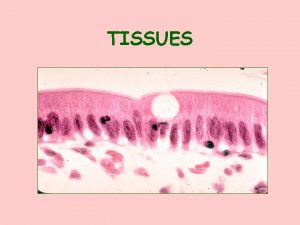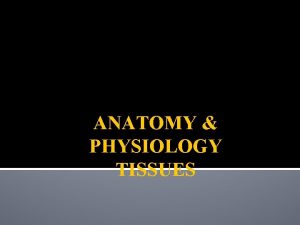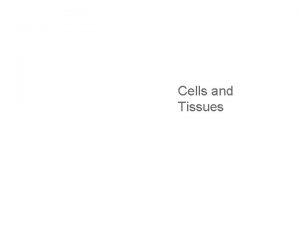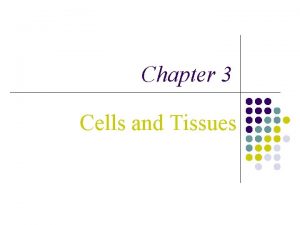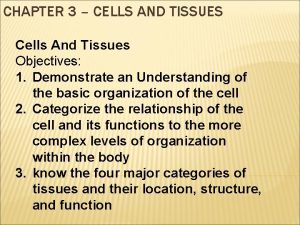Tissues Groups of cells similar in structure and













































- Slides: 45

Tissues § Groups of cells similar in structure and function § The four types of tissues § Epithelial § Connective § Muscle § Nerve Copyright © 2004 Pearson Education, Inc. , publishing as Benjamin Cummings

Epithelial Tissue § Cellularity – composed almost entirely of cells § Special contacts – form continuous sheets held together by tight junctions and desmosomes § Polarity – apical and basal surfaces § Supported by connective tissue – reticular and basal laminae § Avascular but innervated – contains no blood vessels but supplied by nerve fibers § Regenerative – rapidly replaces lost cells by cell division Copyright © 2004 Pearson Education, Inc. , publishing as Benjamin Cummings

Classification of Epithelia § Simple or stratified Copyright © 2004 Pearson Education, Inc. , publishing as Benjamin Cummings Figure 4. 1 a

Classification of Epithelia § Squamous, cuboidal, or columnar Figure 4. 1 b Copyright © 2004 Pearson Education, Inc. , publishing as Benjamin Cummings

Epithelia: Simple Squamous Figure 4. 2 a Copyright © 2004 Pearson Education, Inc. , publishing as Benjamin Cummings

Epithelia: Simple Cuboidal § Single layer of cubelike cells with large, spherical central nuclei § Function in secretion and absorption § Present in kidney tubules, ducts and secretory portions of small glands, and ovary surface Figure 4. 2 b Copyright © 2004 Pearson Education, Inc. , publishing as Benjamin Cummings

Epithelia: Simple Columnar Figure 4. 2 c Copyright © 2004 Pearson Education, Inc. , publishing as Benjamin Cummings

Epithelia: Pseudostratified Columnar § Single layer of cells with different heights; some do not reach the free surface § Nuclei are seen at different layers § Function in secretion and propulsion of mucus § Present in the male sperm-carrying ducts (nonciliated) and trachea (ciliated) Figure 4. 2 d Copyright © 2004 Pearson Education, Inc. , publishing as Benjamin Cummings

Epithelia: Stratified Squamous § Thick membrane composed of several layers of cells § Function in protection of underlying areas subjected to abrasion § Forms the external part of the skin’s epidermis (keratinized cells), and linings of the esophagus, mouth, and vagina (nonkeratinized cells) Figure 4. 2 e Copyright © 2004 Pearson Education, Inc. , publishing as Benjamin Cummings

Epithelia: Transitional § Several cell layers, basal cells are cuboidal, surface cells are dome shaped § Stretches to permit the distension of the urinary bladder § Lines the urinary bladder, ureters, and part of the urethra Figure 4. 2 f Copyright © 2004 Pearson Education, Inc. , publishing as Benjamin Cummings

Epithelia: Glandular § A gland is one or more cells that makes and secretes an aqueous fluid § Classified by: § Site of product release – endocrine or exocrine § Relative number of cells forming the gland – unicellular or multicellular Copyright © 2004 Pearson Education, Inc. , publishing as Benjamin Cummings

Endocrine Glands § Ductless glands that produce hormones § Secretions include amino acids, proteins, glycoproteins, and steroids Copyright © 2004 Pearson Education, Inc. , publishing as Benjamin Cummings

Exocrine Glands § More numerous than endocrine glands § Secrete their products onto body surfaces (skin) or into body cavities § Examples include mucous, sweat, oil, and salivary glands § The only important unicellular gland is the goblet cell § Multicellular exocrine glands are composed of a duct and secretory unit Copyright © 2004 Pearson Education, Inc. , publishing as Benjamin Cummings

Modes of Secretion § Merocrine – products are secreted by exocytosis (e. g. , pancreas, sweat, and salivary glands) § Holocrine – products are secreted by the rupture of gland cells (e. g. , sebaceous glands) Copyright © 2004 Pearson Education, Inc. , publishing as Benjamin Cummings

Modes of Secretion Figure 4. 4 Copyright © 2004 Pearson Education, Inc. , publishing as Benjamin Cummings

Connective Tissue § Found throughout the body; most abundant and widely distributed in primary tissues § Connective tissue proper § Cartilage § Bone § Blood Copyright © 2004 Pearson Education, Inc. , publishing as Benjamin Cummings

Connective Tissue Copyright © 2004 Pearson Education, Inc. , publishing as Benjamin Cummings Figure 4. 5

Functions of Connective Tissue § Binding and support § Protection § Insulation § Transportation Copyright © 2004 Pearson Education, Inc. , publishing as Benjamin Cummings

Characteristics of Connective Tissue § Connective tissues have: § Mesenchyme as their common tissue of origin § Varying degrees of vascularity § Nonliving extracellular matrix, consisting of ground substance and fibers Copyright © 2004 Pearson Education, Inc. , publishing as Benjamin Cummings

Structural Elements of Connective Tissue § Ground substance – unstructured material that fills the space between cells § Fibers – collagen, elastic, or reticular § Cells – fibroblasts, chondroblasts, osteoblasts, and hematopoietic stem cells Copyright © 2004 Pearson Education, Inc. , publishing as Benjamin Cummings

Ground Substance § Interstitial (tissue) fluid § Adhesion proteins – fibronectin and laminin § Proteoglycans – glycosaminoglycans (GAGs) § Functions as a molecular sieve through which nutrients diffuse between blood capillaries and cells Copyright © 2004 Pearson Education, Inc. , publishing as Benjamin Cummings

Fibers § Collagen – tough; provides high tensile strength § Elastic – long, thin fibers that allow for stretch § Reticular – branched collagenous fibers that form delicate networks Copyright © 2004 Pearson Education, Inc. , publishing as Benjamin Cummings

Cells § Fibroblasts – connective tissue proper § Chondroblasts – cartilage § Osteoblasts – bone § Hematopoietic stem cells – blood § White blood cells, plasma cells, macrophages, and mast cells Copyright © 2004 Pearson Education, Inc. , publishing as Benjamin Cummings

Connective Tissue: Embryonic Figure 4. 8 a Copyright © 2004 Pearson Education, Inc. , publishing as Benjamin Cummings

Connective Tissue Proper: Loose Figure 4. 8 b Copyright © 2004 Pearson Education, Inc. , publishing as Benjamin Cummings

Connective Tissue Proper: Loose Figure 4. 8 c Copyright © 2004 Pearson Education, Inc. , publishing as Benjamin Cummings

Connective Tissue Proper: Loose Figure 4. 8 d Copyright © 2004 Pearson Education, Inc. , publishing as Benjamin Cummings

Connective Tissue Proper: Dense Regular Figure 4. 8 e Copyright © 2004 Pearson Education, Inc. , publishing as Benjamin Cummings

Connective Tissue Proper: Dense Irregular Figure 4. 8 f Copyright © 2004 Pearson Education, Inc. , publishing as Benjamin Cummings

Connective Tissue: Hyaline Cartilage Figure 4. 8 g Copyright © 2004 Pearson Education, Inc. , publishing as Benjamin Cummings

Connective Tissue: Elastic Cartilage § Similar to hyaline cartilage but with more elastic fibers § Maintains shape and structure while allowing flexibility § Supports external ear (pinna) and the epiglottis Figure 4. 8 h Copyright © 2004 Pearson Education, Inc. , publishing as Benjamin Cummings

Connective Tissue: Fibrocartilage Cartilage § Matrix similar to hyaline cartilage but less firm with thick collagen fibers § Provides tensile strength and absorbs compression shock § Found in intervertebral discs, the pubic symphysis, and in discs of the knee joint Figure 4. 8 i Copyright © 2004 Pearson Education, Inc. , publishing as Benjamin Cummings

Connective Tissue: Bone (Osseous Tissue) Figure 4. 8 j Copyright © 2004 Pearson Education, Inc. , publishing as Benjamin Cummings

Connective Tissue: Blood Figure 4. 8 k Copyright © 2004 Pearson Education, Inc. , publishing as Benjamin Cummings

Epithelial Membranes § Cutaneous – skin Figure 4. 9 a Copyright © 2004 Pearson Education, Inc. , publishing as Benjamin Cummings

Epithelial Membranes § Mucous – lines body cavities open to the exterior (e. g. , digestive and respiratory tracts) § Serous – moist membranes found in closed ventral body cavity Figure 4. 9 b Copyright © 2004 Pearson Education, Inc. , publishing as Benjamin Cummings

Epithelial Membranes Figure 4. 9 c Copyright © 2004 Pearson Education, Inc. , publishing as Benjamin Cummings

Nervous Tissue Figure 4. 10 Copyright © 2004 Pearson Education, Inc. , publishing as Benjamin Cummings

Muscle Tissue: Skeletal § Long, cylindrical, multinucleate cells with obvious striations § Initiates and controls voluntary movement § Found in skeletal muscles that attach to bones or skin Figure 4. 11 a Copyright © 2004 Pearson Education, Inc. , publishing as Benjamin Cummings

Muscle Tissue: Cardiac § Branching, striated, uninucleate cells interdigitating at intercalated discs § Propels blood into the circulation § Found in the walls of the heart Figure 4. 11 b Copyright © 2004 Pearson Education, Inc. , publishing as Benjamin Cummings

Muscle Tissue: Smooth Figure 4. 11 c Copyright © 2004 Pearson Education, Inc. , publishing as Benjamin Cummings

Tissue Trauma § Causes inflammation, characterized by: § Dilation of blood vessels § Increase in vessel permeability § Redness, heat, swelling, and pain Copyright © 2004 Pearson Education, Inc. , publishing as Benjamin Cummings

Tissue Repair § Organization and restored blood supply § The blood clot is replaced with granulation tissue § Regeneration and fibrosis § Surface epithelium regenerates and the scab detaches Figure 4. 12 a Copyright © 2004 Pearson Education, Inc. , publishing as Benjamin Cummings

Tissue Repair § Fibrous tissue matures and begins to resemble the adjacent tissue Figure 4. 12 b Copyright © 2004 Pearson Education, Inc. , publishing as Benjamin Cummings

Tissue Repair § Results in a fully regenerated epithelium with underlying scar tissue Figure 4. 12 c Copyright © 2004 Pearson Education, Inc. , publishing as Benjamin Cummings
 Tissues are groups of similar cells working together to
Tissues are groups of similar cells working together to Tissues are groups of similar cells working together to
Tissues are groups of similar cells working together to A group of cells similar in structure and function
A group of cells similar in structure and function Body tissues chapter 3 cells and tissues
Body tissues chapter 3 cells and tissues 4 body tissues
4 body tissues Body tissues chapter 3 cells and tissues
Body tissues chapter 3 cells and tissues Stained cheek cell
Stained cheek cell Cells form tissues. tissues form __________.
Cells form tissues. tissues form __________. Dense regular connective
Dense regular connective Chapter 3 cells and tissues
Chapter 3 cells and tissues Cell membrane phospholipids
Cell membrane phospholipids Smooth endoplasmic
Smooth endoplasmic Groups of cells with a common structure and function.
Groups of cells with a common structure and function. Divisions of anatomy
Divisions of anatomy How are ethnic groups and religious groups related
How are ethnic groups and religious groups related Submentovertical projection
Submentovertical projection Red blood cells and white blood cells difference
Red blood cells and white blood cells difference Venn diagram animal and plant cells
Venn diagram animal and plant cells Masses of cells form and steal nutrients from healthy cells
Masses of cells form and steal nutrients from healthy cells Similar exposure group
Similar exposure group Principal cells vs intercalated cells
Principal cells vs intercalated cells Parafollicular cells vs follicular cells
Parafollicular cells vs follicular cells Somatic vs gamete
Somatic vs gamete Somatic cells vs germ cells
Somatic cells vs germ cells Prokaryotic cells
Prokaryotic cells Prokaryotic cells
Prokaryotic cells The organelle trail
The organelle trail Younger cells cuboidal older cells flattened
Younger cells cuboidal older cells flattened What animals have prokaryotic cells
What animals have prokaryotic cells Prokaryotic cells
Prokaryotic cells Chapter 8 cellular reproduction cells from cells
Chapter 8 cellular reproduction cells from cells Cell substance
Cell substance A group of similar cells working together.
A group of similar cells working together. Similar disuelve a similar
Similar disuelve a similar Unidad de medida de solubilidad
Unidad de medida de solubilidad Lo similar disuelve lo similar
Lo similar disuelve lo similar Precipitancy creates prodigality
Precipitancy creates prodigality Chapter 6 bones and skeletal tissues
Chapter 6 bones and skeletal tissues Capillary
Capillary Fetal station chart
Fetal station chart What are specialized connective tissue
What are specialized connective tissue Types of tissues
Types of tissues Procambium meaning
Procambium meaning 3 tissues of a plant
3 tissues of a plant Stone cells in plants
Stone cells in plants Jane campion tissues
Jane campion tissues

